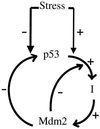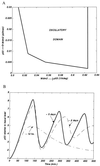Generation of oscillations by the p53-Mdm2 feedback loop: a theoretical and experimental study
- PMID: 11016968
- PMCID: PMC17186
- DOI: 10.1073/pnas.210171597
Generation of oscillations by the p53-Mdm2 feedback loop: a theoretical and experimental study
Abstract
The intracellular activity of the p53 tumor suppressor protein is regulated through a feedback loop involving its transcriptional target, mdm2. We present a simple mathematical model suggesting that, under certain circumstances, oscillations in p53 and Mdm2 protein levels can emerge in response to a stress signal. A delay in p53-dependent induction of Mdm2 is predicted to be required, albeit not sufficient, for this oscillatory behavior. In line with the predictions of the model, oscillations of both p53 and Mdm2 indeed occur on exposure of various cell types to ionizing radiation. Such oscillations may allow cells to repair their DNA without risking the irreversible consequences of continuous excessive p53 activation.
Figures






References
-
- Bennett W P, Hussain S P, Vahakangas K H, Khan M A, Shields P G, Harris C C. J Pathol. 1999;187:8–18. - PubMed
-
- Levine A J. Cell. 1997;88:323–331. - PubMed
-
- Agarwal M L, Taylor W R, Chernov M V, Chernova O B, Stark G R. J Biol Chem. 1998;273:1–4. - PubMed
-
- Prives C, Hall P A. J Pathol. 1999;187:112–126. - PubMed
-
- Oren M. J Biol Chem. 1999;274:36031–36034. - PubMed
Publication types
MeSH terms
Substances
Grants and funding
LinkOut - more resources
Full Text Sources
Other Literature Sources
Research Materials
Miscellaneous

